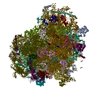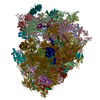+ Open data
Open data
- Basic information
Basic information
| Entry | Database: EMDB / ID: EMD-3223 | |||||||||
|---|---|---|---|---|---|---|---|---|---|---|
| Title | Mammalian 80S HCV-IRES complex, Classical / no head tilt | |||||||||
 Map data Map data | Reconstruction of ribosome complex | |||||||||
 Sample Sample |
| |||||||||
 Keywords Keywords | ribosome / translation initiation / Hepatitis C Virus internal ribosome entry site | |||||||||
| Biological species |   Hepatitis C virus Hepatitis C virus | |||||||||
| Method | single particle reconstruction / cryo EM / Resolution: 5.8 Å | |||||||||
 Authors Authors | Yamamoto H / Collier M / Loerke J / Ismer J / Schmidt A / Hilal T / Sprink T / Yamamoto K / Mielke T / Burger J ...Yamamoto H / Collier M / Loerke J / Ismer J / Schmidt A / Hilal T / Sprink T / Yamamoto K / Mielke T / Burger J / Shaikh TR / Dabrowski M / Hildebrand PW / Scheerer P / Spahn CMT | |||||||||
 Citation Citation |  Journal: EMBO J / Year: 2015 Journal: EMBO J / Year: 2015Title: Molecular architecture of the ribosome-bound Hepatitis C Virus internal ribosomal entry site RNA. Authors: Hiroshi Yamamoto / Marianne Collier / Justus Loerke / Jochen Ismer / Andrea Schmidt / Tarek Hilal / Thiemo Sprink / Kaori Yamamoto / Thorsten Mielke / Jörg Bürger / Tanvir R Shaikh / ...Authors: Hiroshi Yamamoto / Marianne Collier / Justus Loerke / Jochen Ismer / Andrea Schmidt / Tarek Hilal / Thiemo Sprink / Kaori Yamamoto / Thorsten Mielke / Jörg Bürger / Tanvir R Shaikh / Marylena Dabrowski / Peter W Hildebrand / Patrick Scheerer / Christian M T Spahn /   Abstract: Internal ribosomal entry sites (IRESs) are structured cis-acting RNAs that drive an alternative, cap-independent translation initiation pathway. They are used by many viruses to hijack the ...Internal ribosomal entry sites (IRESs) are structured cis-acting RNAs that drive an alternative, cap-independent translation initiation pathway. They are used by many viruses to hijack the translational machinery of the host cell. IRESs facilitate translation initiation by recruiting and actively manipulating the eukaryotic ribosome using only a subset of canonical initiation factor and IRES transacting factors. Here we present cryo-EM reconstructions of the ribosome 80S- and 40S-bound Hepatitis C Virus (HCV) IRES. The presence of four subpopulations for the 80S•HCV IRES complex reveals dynamic conformational modes of the complex. At a global resolution of 3.9 Å for the most stable complex, a derived atomic model reveals a complex fold of the IRES RNA and molecular details of its interaction with the ribosome. The comparison of obtained structures explains how a modular architecture facilitates mRNA loading and tRNA binding to the P-site. This information provides the structural foundation for understanding the mechanism of HCV IRES RNA-driven translation initiation. | |||||||||
| History |
|
- Structure visualization
Structure visualization
| Movie |
 Movie viewer Movie viewer |
|---|---|
| Structure viewer | EM map:  SurfView SurfView Molmil Molmil Jmol/JSmol Jmol/JSmol |
| Supplemental images |
- Downloads & links
Downloads & links
-EMDB archive
| Map data |  emd_3223.map.gz emd_3223.map.gz | 15.2 MB |  EMDB map data format EMDB map data format | |
|---|---|---|---|---|
| Header (meta data) |  emd-3223-v30.xml emd-3223-v30.xml emd-3223.xml emd-3223.xml | 10.9 KB 10.9 KB | Display Display |  EMDB header EMDB header |
| Images |  EMD-4-3223.png EMD-4-3223.png | 208.3 KB | ||
| Archive directory |  http://ftp.pdbj.org/pub/emdb/structures/EMD-3223 http://ftp.pdbj.org/pub/emdb/structures/EMD-3223 ftp://ftp.pdbj.org/pub/emdb/structures/EMD-3223 ftp://ftp.pdbj.org/pub/emdb/structures/EMD-3223 | HTTPS FTP |
-Validation report
| Summary document |  emd_3223_validation.pdf.gz emd_3223_validation.pdf.gz | 260.3 KB | Display |  EMDB validaton report EMDB validaton report |
|---|---|---|---|---|
| Full document |  emd_3223_full_validation.pdf.gz emd_3223_full_validation.pdf.gz | 259.4 KB | Display | |
| Data in XML |  emd_3223_validation.xml.gz emd_3223_validation.xml.gz | 7.3 KB | Display | |
| Arichive directory |  https://ftp.pdbj.org/pub/emdb/validation_reports/EMD-3223 https://ftp.pdbj.org/pub/emdb/validation_reports/EMD-3223 ftp://ftp.pdbj.org/pub/emdb/validation_reports/EMD-3223 ftp://ftp.pdbj.org/pub/emdb/validation_reports/EMD-3223 | HTTPS FTP |
-Related structure data
- Links
Links
| EMDB pages |  EMDB (EBI/PDBe) / EMDB (EBI/PDBe) /  EMDataResource EMDataResource |
|---|---|
| Related items in Molecule of the Month |
- Map
Map
| File |  Download / File: emd_3223.map.gz / Format: CCP4 / Size: 204.4 MB / Type: IMAGE STORED AS FLOATING POINT NUMBER (4 BYTES) Download / File: emd_3223.map.gz / Format: CCP4 / Size: 204.4 MB / Type: IMAGE STORED AS FLOATING POINT NUMBER (4 BYTES) | ||||||||||||||||||||||||||||||||||||||||||||||||||||||||||||||||||||
|---|---|---|---|---|---|---|---|---|---|---|---|---|---|---|---|---|---|---|---|---|---|---|---|---|---|---|---|---|---|---|---|---|---|---|---|---|---|---|---|---|---|---|---|---|---|---|---|---|---|---|---|---|---|---|---|---|---|---|---|---|---|---|---|---|---|---|---|---|---|
| Annotation | Reconstruction of ribosome complex | ||||||||||||||||||||||||||||||||||||||||||||||||||||||||||||||||||||
| Projections & slices | Image control
Images are generated by Spider. | ||||||||||||||||||||||||||||||||||||||||||||||||||||||||||||||||||||
| Voxel size | X=Y=Z: 1.07 Å | ||||||||||||||||||||||||||||||||||||||||||||||||||||||||||||||||||||
| Density |
| ||||||||||||||||||||||||||||||||||||||||||||||||||||||||||||||||||||
| Symmetry | Space group: 1 | ||||||||||||||||||||||||||||||||||||||||||||||||||||||||||||||||||||
| Details | EMDB XML:
CCP4 map header:
| ||||||||||||||||||||||||||||||||||||||||||||||||||||||||||||||||||||
-Supplemental data
- Sample components
Sample components
-Entire : Mammalian 80S HCV-IRES complex, Classical / no head tilt
| Entire | Name: Mammalian 80S HCV-IRES complex, Classical / no head tilt |
|---|---|
| Components |
|
-Supramolecule #1000: Mammalian 80S HCV-IRES complex, Classical / no head tilt
| Supramolecule | Name: Mammalian 80S HCV-IRES complex, Classical / no head tilt type: sample / ID: 1000 / Number unique components: 3 |
|---|---|
| Molecular weight | Theoretical: 4.6 MDa |
-Supramolecule #1: 80S ribosome
| Supramolecule | Name: 80S ribosome / type: complex / ID: 1 / Recombinant expression: No / Ribosome-details: ribosome-eukaryote: ALL |
|---|---|
| Source (natural) | Organism:  |
| Molecular weight | Theoretical: 4.5 MDa |
-Macromolecule #1: HCV-IRES
| Macromolecule | Name: HCV-IRES / type: rna / ID: 1 / Classification: OTHER / Structure: DOUBLE HELIX / Synthetic?: Yes |
|---|---|
| Source (natural) | Organism:  Hepatitis C virus / synonym: HCV Hepatitis C virus / synonym: HCV |
| Molecular weight | Theoretical: 162 KDa |
| Sequence | String: GCCAGCCCCC UGAUGGGGGC GACACUCCAC CAUGAAUCAC UCCCCUGUGA GGAACUACUG UCUUCACGCA GAAAGCGUCU AGCCAUGGCG UUAGUAUGAG UGUCGUGCAG CCUCCAGGAC CCCCCCUCCC GGGAGAGCCA UAGUGGUCUG CGGAACCGGU GAGUACACCG ...String: GCCAGCCCCC UGAUGGGGGC GACACUCCAC CAUGAAUCAC UCCCCUGUGA GGAACUACUG UCUUCACGCA GAAAGCGUCU AGCCAUGGCG UUAGUAUGAG UGUCGUGCAG CCUCCAGGAC CCCCCCUCCC GGGAGAGCCA UAGUGGUCUG CGGAACCGGU GAGUACACCG GAAUUGCCAG GACGACCGGG UCCUUUCUUG GAUAAACCCG CUCAAUGCCU GGAGAUUUGG GCGUGCCCCC GCAAGACUGC UAGCCGAGUA GUGUUGGGUC GCGAAAGGCC UUGUGGUACU GCCUGAUAGG GUGCUUGCGA GUGCCCCGGG AGGUCUCGUA GACCGUGCAC CAUGAGCACG AAUCCUAAAC CUCAAAGAAA AACCAAACGU AACACCAACC GUCGCCCACA GGACGUCAAG UUCCCGGGUG GCGGUCUAGA CGCCGAGAUC AGAAAUCCCU CUCUCGGAUC GCAUUUGGAC UUCUGCCUUC GGGCACCACG GUCGGAUCCG AAUU |
-Macromolecule #2: tRNA
| Macromolecule | Name: tRNA / type: rna / ID: 2 / Details: Rabbit reticulocyte / Classification: OTHER / Structure: DOUBLE HELIX / Synthetic?: No |
|---|---|
| Source (natural) | Organism:  |
| Molecular weight | Theoretical: 2.5 KDa |
-Experimental details
-Structure determination
| Method | cryo EM |
|---|---|
 Processing Processing | single particle reconstruction |
| Aggregation state | particle |
- Sample preparation
Sample preparation
| Buffer | pH: 7.6 Details: 20mM Tris-HCl, 7.5mM MgCl2, 100mM KCl, 0.2mM spermidine, 2mM DTT |
|---|---|
| Grid | Details: Quantifoil R3-3 Cu 300 mesh with 2 nm carbon support film |
| Vitrification | Cryogen name: ETHANE / Chamber humidity: 100 % / Chamber temperature: 93 K / Instrument: FEI VITROBOT MARK I / Method: blot for 2-4 seconds before plunging |
- Electron microscopy
Electron microscopy
| Microscope | FEI TITAN KRIOS |
|---|---|
| Date | Oct 16, 2014 |
| Image recording | Category: CCD / Film or detector model: FEI FALCON II (4k x 4k) / Number real images: 7707 / Average electron dose: 20 e/Å2 / Details: Automated data collection using EPU |
| Electron beam | Acceleration voltage: 300 kV / Electron source:  FIELD EMISSION GUN FIELD EMISSION GUN |
| Electron optics | Calibrated magnification: 130293 / Illumination mode: FLOOD BEAM / Imaging mode: BRIGHT FIELD / Cs: 2.7 mm / Nominal defocus max: 4.0 µm / Nominal defocus min: 1.0 µm / Nominal magnification: 75000 |
| Sample stage | Specimen holder model: FEI TITAN KRIOS AUTOGRID HOLDER |
| Experimental equipment |  Model: Titan Krios / Image courtesy: FEI Company |
- Image processing
Image processing
| CTF correction | Details: CTFFIND3 |
|---|---|
| Final reconstruction | Applied symmetry - Point group: C1 (asymmetric) / Resolution.type: BY AUTHOR / Resolution: 5.8 Å / Resolution method: OTHER / Software - Name: spider Details: To avoid overfitting, the data was refined in a resolution-limited scheme using SPIDER. Number images used: 44419 |
 Movie
Movie Controller
Controller



















 Z (Sec.)
Z (Sec.) X (Row.)
X (Row.) Y (Col.)
Y (Col.)





















